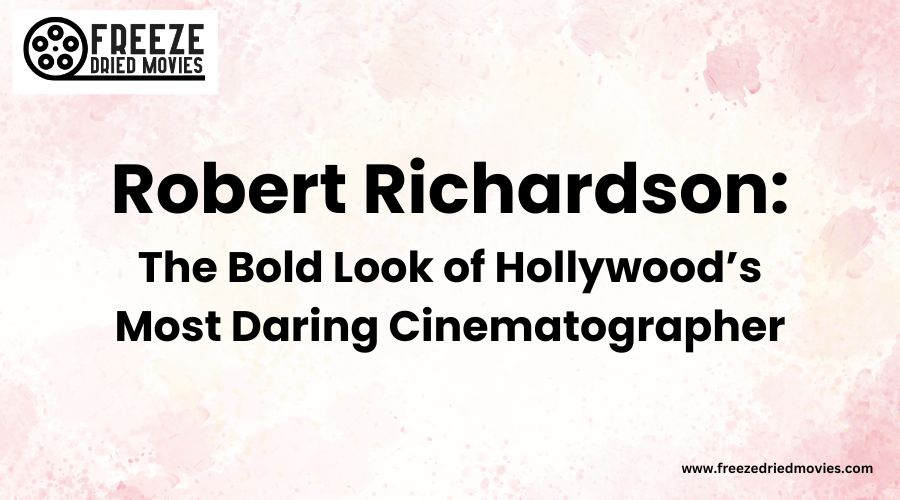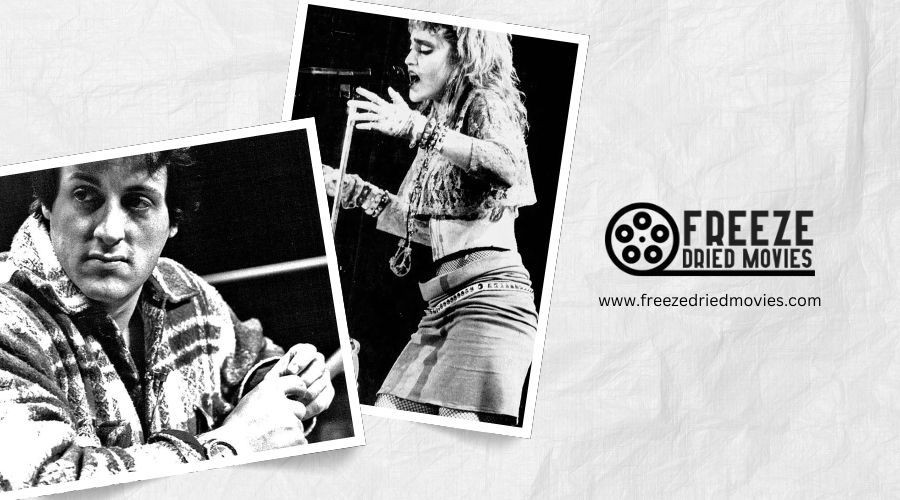Robert Richardson: The Bold Look of Hollywood’s Most Daring Cinematographer

Robert Richardson's cinematography revolutionized Hollywood with his signature "halo effect" rim lighting and bold color choices. You'll recognize his work through vibrant images that outline subjects against darker backgrounds, creating dramatic tension. His collaborations with Tarantino, Scorsese, and Stone showcase his ability to craft distinctive visual narratives while respecting production design. His hands-on approach, often operating cameras himself, reflects his artistic intuition and technical precision. Discover how this three-time Oscar winner transforms good filmmaking into unforgettable visual art.
Key Takeaways
- Richardson's signature halo effect using rim and top lighting creates bold images with strong colors and dramatic tension.
- His collaborations with Tarantino feature vibrant colors and crisp imagery that amplify dialogue and build narrative tension.
- Richardson personally operates camera equipment, often riding alongside on Pegasus cranes for intimate control of composition.
- His deliberate overexposure technique produces electric edges around subjects, recalling the revolutionary Technicolor process.
- Richardson views cinematography as an extension of production design, weaving consistent visual threads through diverse environments.
Numeric List of 10 Second-Level Headings
Before diving into Robert Richardson's illustrious career, you'll need a roadmap to navigate his artistic journey. This celebrated cinematographer has shaped modern cinema through his distinctive visual style and bold choices. Much like cinematographers of the 1930s who pioneered deep focus techniques for narrative depth, Richardson continues this tradition with his own innovative approach.
Richardson's cinematic vision transforms films into visual masterpieces through bold artistic choices and unmistakable style.
Our exploration will cover:
- Early Life and Influences
- First Steps in Filmmaking
- Partnership with Oliver Stone
- Visual Storytelling Techniques
- Collaboration with Scorsese and Quentin Tarantino
- Signature Lighting Approaches
- Three Academy Awards for Cinematography
- Technical Innovations
- Creative Decisions Behind Iconic Scenes
- Legacy and Influence on Modern Filmmakers
Each section will unpack how Richardson transformed visual narratives through his unique perspective. You'll discover the meticulous craft behind his most stunning compositions and understand why directors continually seek his visionary eye for their most ambitious projects.
The Signature Visual Style of Robert Richardson
With our roadmap of Richardson's journey established, let's turn our attention to the visual fingerprint that makes his work instantly recognizable. You'll notice Richardson's cinematography thrives on bold, vibrant images where strong colors and stylized lighting create emotional depth. His strategic use of rim and top lighting produces that distinctive "halo" effect around characters, giving directors like Quentin Tarantino remarkable flexibility during filming.
Much like the cinematographers who mastered Technicolor's three-color process, Richardson employs color to sculpt emotions and mold narratives in his distinctive visual style. Watch how Richardson outlines his subjects against darker backgrounds, creating a dramatic visual tension evident in scenes like the farmhouse sequence in Inglourious Basterds. This approach isn't just technically impressive—it's purposeful visual storytelling. His lighting techniques adapt seamlessly across diverse environments while maintaining a consistent aesthetic thread throughout each film.
Richardson's visual style doesn't just capture images; it elevates narrative through a deliberate, unmistakable look that's become his signature.
Richardson's Pioneering Approach to Camera Operation
While many cinematographers delegate the physical operation of cameras to specialized technicians, Richardson boldly breaks from this tradition by insisting on manning the camera himself. This hands-on approach creates an unfiltered physical connection between the artist and his visual storytelling.
You'll notice three distinctive elements in his pioneering technique:
- He regularly uses a viewfinder to isolate the frame, immersing himself completely in the composition before committing to camera movements
- Rather than directing from afar, he rides alongside the remote head on Pegasus cranes, maintaining intimate control over each shot
- His operating the camera personally reflects a deep commitment to following his visual instincts without intermediaries
This direct engagement with the equipment represents the essence of Richardson's daring cinematographic approach—where technical precision meets artistic intuition. Richardson's methods enhance sound and image integration, benefiting from advancements in Foley artistry that perfectly complement his carefully composed visual sequences.
The Art of Rim Lighting: Richardson's Lighting Techniques
Among Richardson's most recognizable visual signatures, his masterful use of rim lighting stands as a hallmark of his artistic boldness. You'll notice his distinctive approach creates a halo effect around subjects, adding depth and dimension to every frame. By employing strong rim lighting from the back or above, he maintains flexibility for both the camera on a Pegasus and actor positioning throughout complex scenes.
This technique recalls the revolutionary 3-color Technicolor process that transformed visual storytelling in the 1930s. The Spahn Ranch sequence in Once Upon a Time in Hollywood perfectly demonstrates this technique—dramatic outlines define characters against dusty backgrounds, evoking a modern take on three-color Technicolor aesthetics. Richardson's practice of deliberately overexposing the rim light produces an electric quality when captured on film, generating vibrant edges that enhance emotional storytelling.
This stylized approach elevates the visual impact of every project he touches.
The Tarantino Collaboration: Crafting Visual Narratives
Three decades of cinematic innovation define the legendary partnership between Richardson and Quentin Tarantino, a collaboration that has produced some of modern cinema's most visually striking moments.
Since Kill Bill, Richardson has elevated Tarantino's storytelling through his masterful lens, creating distinctive visual signatures for each project.
Richardson's work on Inglourious Basterds exemplifies their synergy, where he balanced chapter-specific visual looks while maintaining narrative cohesion through:
- Vibrant colors that punctuate emotional beats and enhance period authenticity
- Bold lighting schemes that sculpt characters and environments with dramatic purpose
- Crisp, electric imagery that amplifies Tarantino's sharp-witted dialogue and builds tension
You'll notice Richardson's technical versatility across diverse environments, whether capturing intimate conversations or explosive action sequences—always serving the director's vision while adding his distinctive visual flair.
From Film to Digital: Richardson's Technical Evolution
Richardson's technical journey through Hollywood mirrors the industry's monumental shift from celluloid to digital. In his early career, he battled with inconsistent film labs, limiting his creative risks with color correction. But as you'd expect from a master, he evolved.
Digital filmmaking revolutionized his approach, offering unprecedented on-set monitoring and hands-on color work opportunities. While he appreciates digital's ability to mimic various film stocks, Richardson acknowledges certain effects—like three-strip Technicolor—remain challenging to flawlessly reproduce.
You'll find Richardson is uncommonly committed to the color grading process, often going beyond typical involvement to guarantee his creative vision translates to the final product. He values colorists as essential collaborators, recognizing that their passion and expertise profoundly impact the visual storytelling he's known for.
The Colorist's Dance: Richardson's Post-Production Philosophy
When the cameras stop rolling and the final frame is captured, the intricate dance between Richardson and his colorists truly begins. Behind the camera, Richardson's work enters a pivotal phase where creative vision meets technical execution.
The cinematography three—Richardson, director, and colorist—work together to:
- Resolve creative differences when the team disagrees on color grading choices
- Fine-tune emotional tones within a compressed timeframe, often adjusting an entire film in days
- Push the creative boundaries that Richardson initially established during filming
You'll notice Richardson values colorists who bring enthusiasm and passion to the table. Their collaborative spirit transforms good cinematography into great art. This philosophy defines Richardson's approach: the creative team's collective input leads to his most stunning visual achievements.
Production Design as the Foundation of Cinematography
Although many viewers focus on the stunning visual compositions and lighting, at the heart of Richardson's cinematographic philosophy lies a profound respect for production design. Rather than delegating responsibility for a film's visual impact, Richardson believes good production design serves as the backbone of his work.
"I see my role as amplifying what's already there," he often remarks. "The textures, atmospheres, and physical spaces give me something authentic to capture and elevate through light."
This philosophy shines in projects like Once Upon a Time in Hollywood, where the recreation of a specific time and place was essential to the narrative. Richardson positions himself at the top or back of the creative process, seeing cinematography not as a standalone art but as an extension of the world production designers meticulously craft.
Creating Visual Cohesion Across Diverse Settings
The challenge of maintaining visual unity across radically different environments serves as one of Richardson's greatest strengths as evidenced in Inglourious Basterds. When you examine his work, you'll notice how he weaves a consistent visual thread throughout Tarantino's narrative while still giving each setting its unique personality.
Richardson's approach to visual cohesion includes:
- Employing bold color palettes that shift subtly between scenes while maintaining a recognizable aesthetic
- Creating seamless passages from bright countryside exteriors to dimly lit interiors without losing the film's visual language
- Utilizing distinctive camerawork techniques that become signature elements across all chapters
His cinematography transforms potentially disconnected chapters into a cohesive whole, allowing you to experience each environment uniquely while never losing sight of the larger visual story.
The Physical Connection: Richardson's Hands-On Methodology
Beyond the cohesive visual language that unites Richardson's work lies a deeply physical approach to his craft. You'll rarely find Robert Richardson delegating camera operation to others. Instead, he insists on manning the equipment personally, maintaining an intimate connection with the visual storytelling process.
Watch Richardson on set and you'll see him riding alongside the camera on a Pegasus crane, immersing himself completely in each shot. Rather than relying on monitors that distance him from the image, he opts for the direct perspective of a viewfinder, isolating the frame and focusing intently on composition.
This hands-on methodology isn't just preference—it's fundamental to Richardson's distinctive cinematography. His physical engagement with the camera reflects both his instinctual approach and meticulous attention to visual detail.




